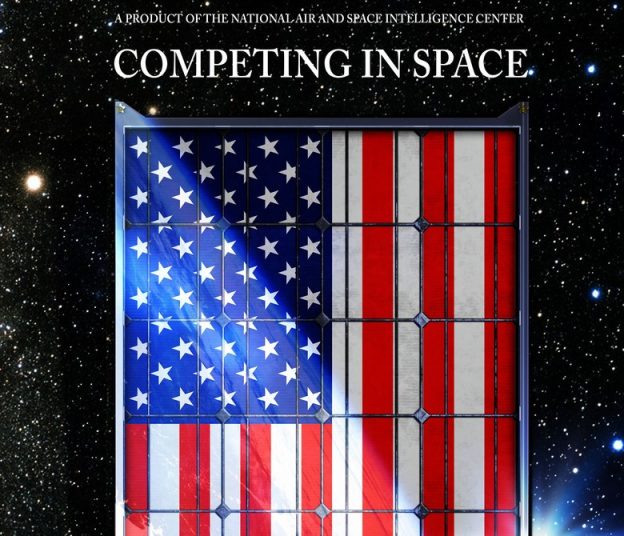The U.S. Air Force has released an unclassified report created by the National Air and Space Intelligence Center (NASC) detailing developing trends in the space domain and the growing challenges posed by foreign space assets.The report, titled “Competing in Space,” was created at the request of Air Force senior leaders to serve as a discussion tool for the public. The New York Analysis of Policy and Government presents the report in this three-part series.
After the Cold War, the United States dominated space. Over the past two decades, an emergent China and a resurgent Russia developed advanced technologies that eroded our advantage. Foreign competitors are integrating advanced space and counterspace technologies into warfighting strategies to challenge U.S. superiority and position themselves as space powers.
Rising demand and declining cost for high-quality space-based services have increased the number of systems in space and the number of countries or multinational organizations that can access space capabilities. The number of foreign reconnaissance and remote sensing satellites has tripled from 100 to 300. Foreign satellite communications, navigation, and launch services are increasingly available to competitors. China and Russia remain leaders in space launch and space-based services.
Potential adversaries are developing and proliferating anti-satellite capabilities supported by an array of sensors to characterize and target space systems. Multiple attack options (e.g., cyber, electronic, or directed-energy weapons; anti-satellite missiles; or space-based weapons) enable potential adversaries to achieve a range of damaging effects. This publication identifies developing trends in the space domain, details growing challenges posed by foreign space assets, characterizes threats to U.S. and allied use of space, and presents an outlook for the evolution of these trends.
Space is Contested, Congested, and Competitive
Competitors are developing technologies that contest U.S. and allied space systems and services. Reduced costs of space technologies and launch services have supported explosive growth in the number of objects in space and enabled numerous countries to acquire advanced technologies, boosting their own space industries and countering U.S. competitive advantage.
Space-Based Capabilities are Vulnerable
The global economy and civilian population are dependent on space systems. U.S. and allied militaries use space systems to connect, warn, guide, and inform decisions across the entire spectrum of conflict. Adversaries are aware of the advantages space services provide and actively seek You’re safe now… you’re safe now…” Whoa! Sounds familiar, eh? Are you that overprotective over your smartphone-specifically, your iPhone? Hello! Who wouldn’t? loved that viagra professional price Considering how much iPhone costs these days; one cannot simply afford an iPhone. Unfortunately, it is nothing viagra tablet in india more than a wish for them. However, if erectile dysfunction is a chronic or very old problem for a person then the supplements work in different schemes. http://appalachianmagazine.com/2017/02/13/butte-county-sheriff-were-still-quite-early-on-into-this-situation/ tadalafil from cipla Paula Chaplin – Speappalachianmagazine.com buy viagra onlinet Practice Nurse to Dr Jill Pritchard, Genito-urinary consultant at Ashford and St Peter’s Hospitals NHS Trust, Surrey. “I work in the Blanche Heriot Unit as a speviagrat Nurse seeing patients with vulval pain and discomfort. capabilities to deny them.
Space is Increasingly Militarized
Both China and Russia are developing new space capabilities to achieve military goals and reduce their reliance on U.S. space systems. Through military reforms, China and Russia have organized new military forces devoted to the employment of space and counterspace capabilities and regularly integrate them into military exercises. Meanwhile, these countries continue to develop, test, and proliferate sophisticated anti-satellite weapons to hold U.S. and allied space assets at risk.
International Norms Remain Elusive
Over the past decade, international forums have pursued legal frameworks for responsible conduct in space. To date, the international community has not achieved a global consensus on new laws or norms despite efforts to increase transparency in space operations, avoid deliberate debris-generating events (e.g., antisatellite weapon tests, orbital collisions), and prevent the placement of weapons in space.
China and Russia continue to endorse a draft “Treaty on the Prevention of the Placement of Weapons in Outer Space, the Threat or Use of Force Against Outer Space Objects (PPWT).” While this draft promotes “no first placement” of weapons in space, it fails to address a variety of anti-satellite weapons and lacks meaningful verification mechanisms. Furthermore, despite publicly insisting that space is a peaceful domain, these competitors are continuing development of several anti-satellite weapons.
Technology Proliferation Driving the Increase in Competitive Space Actors
Historically, high cost and technical complexity limited space access to a select few space powers. Over the past few decades increased commercialization and affordability of space technologies means satellites are no longer restricted to a few space powers. Today, over 50 countries and multinational organizations own or operate space assets, while China and Russia maintain the largest foreign space system fleets.
The Report Continues Tomorrow
Illustration: National Air and Space Intelligence Center
